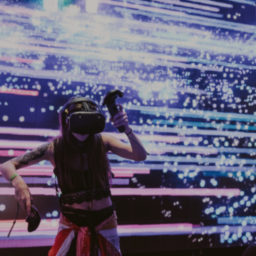Last week, at Sónar+D, I finally got to try out TheWaveVR as the founders were there to demo and pitch in the startup competition. The company has built a way for DJs to perform in VR and bring an audience from around the world together. It does this in a very fun and visual way, and this was probably the first time that a VR experience has made me seriously considering buying a VR setup.
Here’s why.
Over the last decade, I’ve spent a lot of time discovering music on Soundcloud and have seen microgenres rise and fall, with some blowing up and changing the sound of pop (e.g. moombahton, and then ‘EDM trap’). Subcultures and music styles used to be clustered to particular cities, but because of online platforms people from around the world can build on each other’s sounds rapidly. I call it ‘Soundcloud culture’, although the phenomenon is not limited to Soundcloud.
Tools like Turntable.fm, and now Plug.dj, have made it possible for people to gather online into chatrooms and play music to each other. These subcultures have embraced these tools to throw small online gatherings, bringing together all the top producers in their styles for virtual listening parties, or cyber raves.
It’s very akin to the subcultures that exist around video games, and particularly MMORPGs such as World of Warcraft. There’s a sense of community and friendship, because people get to share something they don’t get to do irl (‘in real life’). I’ve written about gamers as a music subculture before, but I haven’t pointed out the connection to Soundcloud culture.
Many of these pioneering DJs and producers in microgenres have nowhere to go. They might not live anywhere with clubs, be too young to go to any, or there might simply not be enough critical mass for their sound to take it into the local clubs. So they take it online, where every niche can find an audience (for an example of a microgenre, check out Gorge). As with many gamers, it becomes far easier for these producers to express themselves virtually than in non-digital settings.
Back to TheWaveVR.
TheWaveVR is taking this to the next level, making the entire experience more immersive. What caught my attention is when Aaron Lemke, one of the founders, explained to me that they’re doing a weekly rave at a set time. All of the above instantly clicked into place.
When gamers have free time, they check out Steam, Battle.net, or similar tools, to see if any of their friends or team members are online, so they can play a round or just sign on, chat, and hang out. Social listening platforms do a similar thing, but they’re not nearly as fun or engaging for the audience as games. For the audience, they’re basically a radio station with a chatroom.
This is what TheWaveVR is changing, by giving the audience visual ways to interact with each other and the DJ. And this is what makes me finally ‘get it’ when it comes to VR: as a media format for social platforms it makes so much sense.
People are skeptical whether virtual reality is ‘the next big thing’ for music. And they’re right: there are many obstacles. But it’s not important. The people pondering such questions are not the target audience for these experiences in the next few years.
Online subcultures are the target audience for VR experiences, and particularly the ones connected to gamer subculture. Gamers are going to be the ones to first embrace this medium, and while the world’s figuring out whether to take it seriously and what to do with it, it’s gamers that will define the soundtrack for the medium: just like they’ve done with YouTube.
